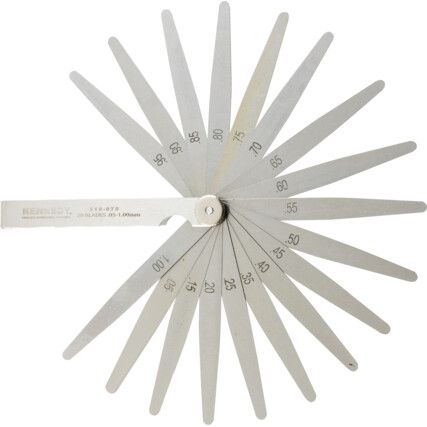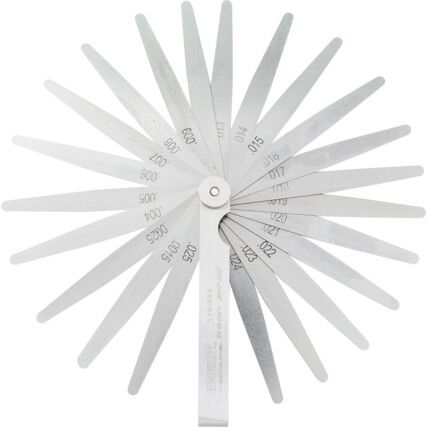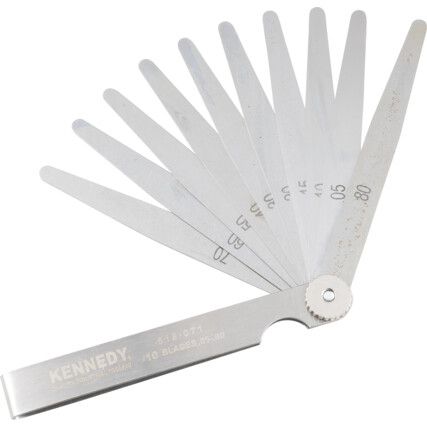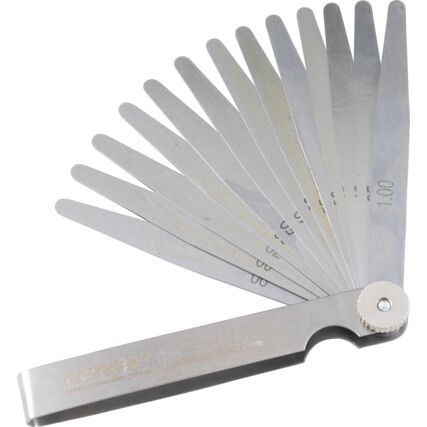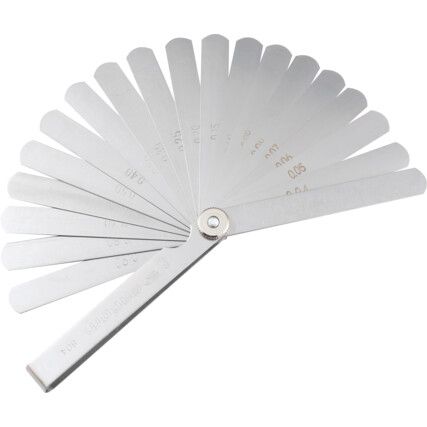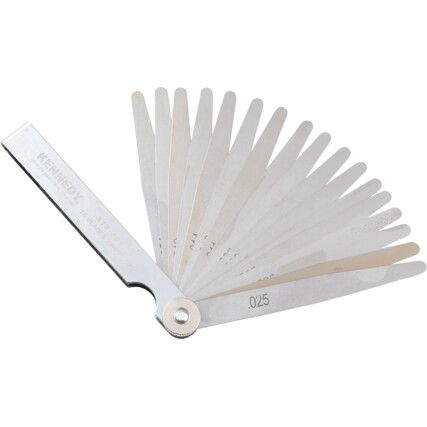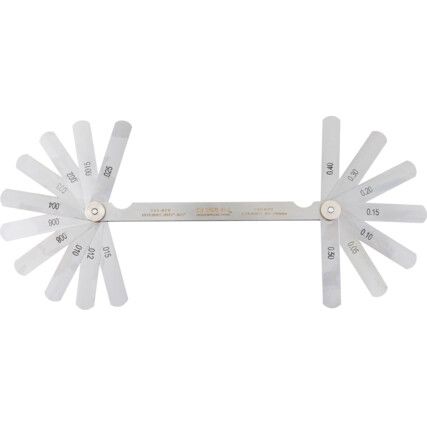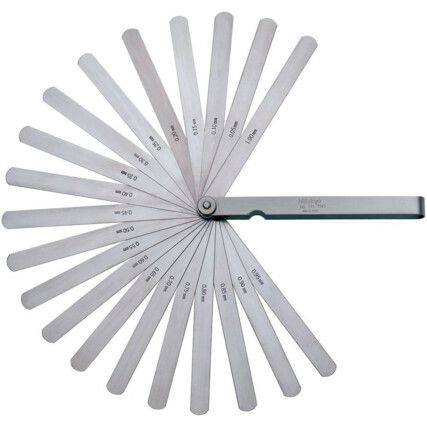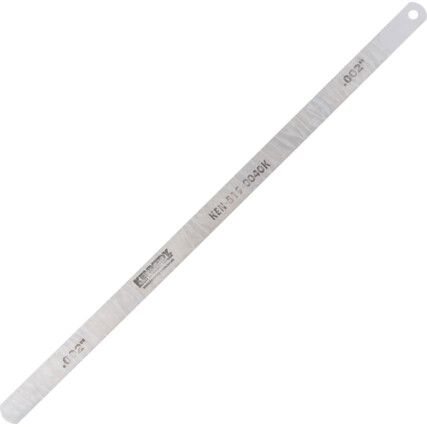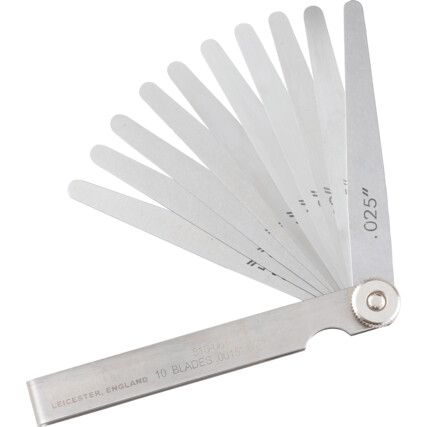Feeler Gauges
A feeler gauge is a hand-held tool used for measuring gap widths between two objects that are close together. The tool is made up of steel blades varying in thickness with measurement markers for easy and accurate recordings.
When are feeler gauges used?
Feeler gauges are most used by mechanical engineers when they need to accurate clearance between two parts. A feeler gauge tool comes in most handy when measuring distances where a calliper or tape measure would not be able to fit.
Feeler gauge types
• Straight leaf or straight blade gauge - The most common type of feeler gauge, consisting of straight blades manufactured from high carbon steel. There are a few variations of this type that are used in varying applications. Variations include long blade and short blade feeler gauges.
• Bent blade (offset) gauge - Provides easier use in areas with restricted movement and accessibility to the gap being measured.
• Tapered blade gauge - A set of blades that become progressively narrower (tapered) towards the blade tip. Useful if there is limited space in the working environment.
• Go/no-go feeler gauge- Feature specialised blades that have a precision step between two specific thicknesses, instead of uniform blades that feature the same thickness across their entirety. These types of gauges are designed to simplify the interpretation of the clearance or gap value by bracketing the clearance or gap value with a greater than/less than tolerance window.
• Wire feeler gauges - These types of feeler gauge replace the use of a shim stock type blade with calibrated metal wires featuring a right-angle bend at the ends. Also known as a wire feeler gauge or a spark plug gap feeler gauge, these gauges are ideal for setting the gap on spark plugs for combustion engines.
Considerations when choosing a feeler gauge
Now you're familiar with the most common types of feeler gauge, picking the right type for the job should feel a little easier. However, with that said, Cromwell has compiled this hand guide to help outline the main things to consider when selecting a feeler gauge.
• Number of blades/leaves - Feeler gauge sets can come with a various number of blades, from 10 or less with the most common, blade counts ranging from 13, 15, 25, 26, 31, with some sets featuring over 100 blades.
• Blade material - Selecting the right material for your feeler gauge set is dependant on the application intended. Carbon steel and stainless-steel blades are commonly used, but other materials such as brass and plastic blades are also used depending on the application. Carbon steel and stainless-steel blades are durable and long lasting, stainless-steel also has the advantage of being resistant to high temperatures. Brass will not cause a spark while in use making it ideal for environments where there could potentially be flammable or explosive materials. It is also non-corrosive and non-magnetic making it suitable for applications involving electronics. Plastic blades whilst being typically less durable than their metal counterparts benefit from being non-corrosive, non-sparking, non-marring, and non-magnetic. Some sets of feeler gauges offer blades made from multiple materials, for example steel and brass blades.
• Blade length - As a standard, blade lengths are typically around 3-5 inches, longer blades of 12 inches are available along with shorter blades around ¾ - 1 inch.
• Imperial or metric sizing - Feeler gauge sets are available in both imperial sizing (inches) and decimal millimetre sizes. Selecting the right sizing will be dependent on whether the application is predominantly using imperial or metric measurements.
• Blade housing - The fan-fold style blade housing is common, where the blades fold into the handle when not in use much like a pocket multi tool. Some feeler gauge sets have the blades individually stored in a slotted pouch rather than connected physically together.
Feeler gauge jargon buster
We want to make it easy for you, so here are some key terms that will help you understand the range and applications a little better.
Blade/leaves - The part of a feeler gauge that does the work, usually made from steel with metric or imperial markers to take readings.
Taper - A progressive narrowing towards the tip of the blade, primarily found on tapered gauges.
Set - The term commonly attributed to a collection of blades housed inside the handle, although individual blades stored in a pouch are referred to by the same moniker.
FAQs
Do feeler gauges need calibration?
Over time measuring equipment is exposed to the rough and tumble of working environments, dents, slight bends, and dings can all have an effect on the tools accuracy and feeler gauges are no exception. As a rule, we would recommend that you have your gauge sets tested every 12 months to see if they are compliant with ISO/IEC 17025:2017 standards.
What are brass feeler gauges used for?
Brass feeler gauges are commonly used in place of steel for applications involving electronics due to its lack of magnetism.
